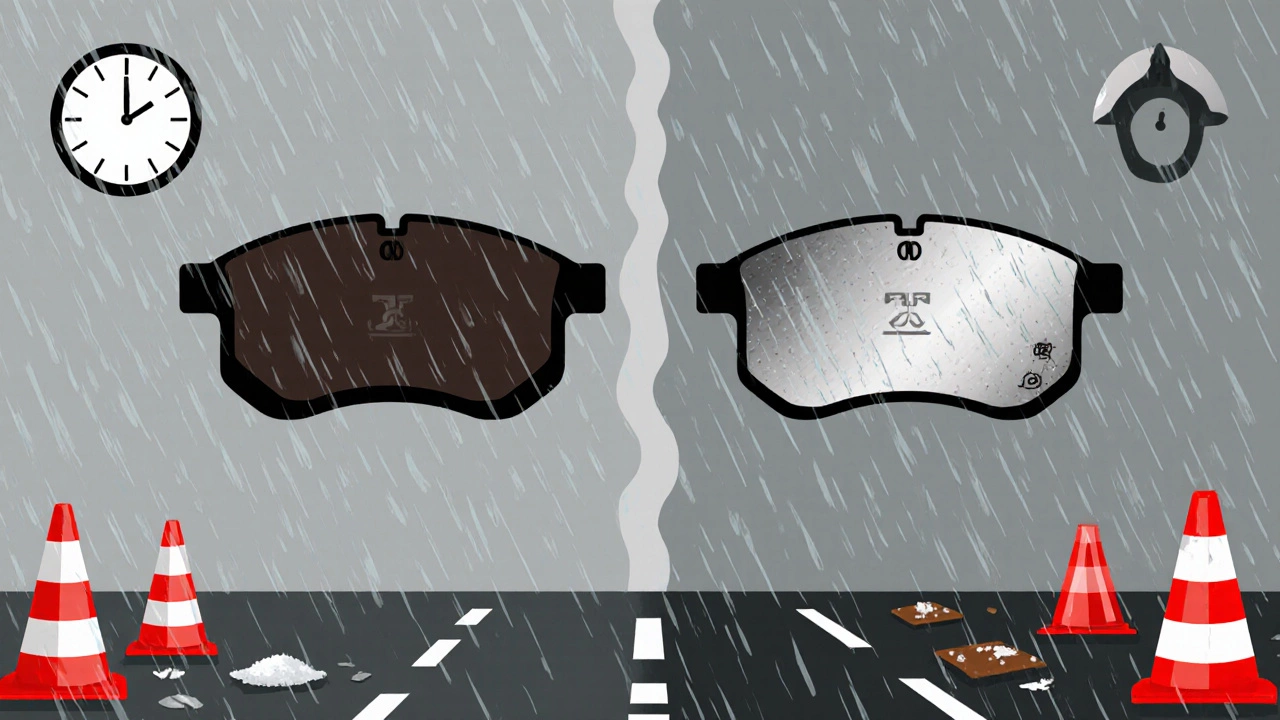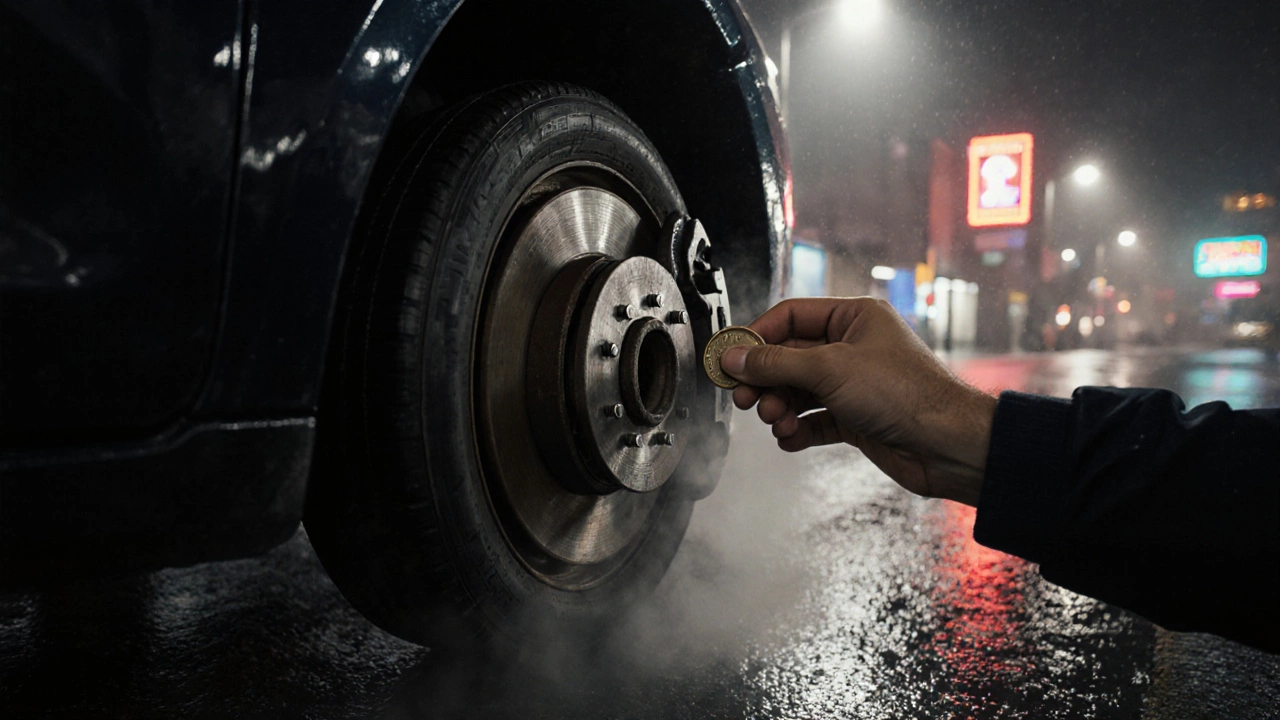Brake Pad Replacement Calculator
Calculate your personalized brake pad replacement schedule based on your driving habits and vehicle type.
Your Brake Pad Replacement Estimate
Estimated remaining mileage:
0
Recommended check interval:
0
Most drivers don’t think about brake pads until they start squealing like a startled cat. But ignoring those noises can turn a simple repair into a dangerous - and expensive - situation. So how often should you really replace brake pads? There’s no one-size-fits-all answer, but knowing what affects wear helps you stay safe without overspending.
Typical Brake Pad Lifespan
On average, brake pads last between 25,000 and 60,000 miles. That’s a wide range, and it’s not because mechanics are guessing. It’s because driving habits, vehicle weight, and road conditions make all the difference.
If you drive mostly on motorways with smooth, steady braking, your pads could hit 60,000 miles. But if you live in Manchester, where traffic jams, stop-start city driving, and wet roads are the norm, you’re more likely to need replacements closer to 30,000 miles. Heavy cars - like SUVs or vans - also wear pads faster. A Ford Focus might get 50,000 miles out of a set. A Land Rover Discovery? Maybe 35,000.
Manufacturers often quote 40,000 to 50,000 miles as a ballpark. But real-world data from UK garage networks shows nearly 60% of drivers replace pads before 40,000 miles. That’s not because they’re reckless - it’s because daily driving conditions eat through friction material faster than lab tests suggest.
Signs You Need New Brake Pads
You don’t need a mechanic to tell you when your pads are worn. Your car will scream at you - if you know what to listen for.
- Squealing or screeching - That high-pitched noise? It’s usually a wear indicator tab rubbing on the rotor. It’s designed to be annoying so you don’t ignore it.
- Grinding metal sound - If you hear a rough, metallic grinding, you’re already damaging your rotors. This means the friction material is gone, and metal is hitting metal. Don’t wait - get it checked today.
- Longer stopping distances - Does it feel like you’re pressing the pedal harder than before? That’s reduced friction. Brake pads thin out, and stopping power drops.
- Vibration or pulsing in the pedal - Warped rotors often come from overheating due to worn pads. The brake system can’t apply even pressure anymore.
- Brake warning light - Some modern cars have sensors that trigger a dashboard alert when pads hit a critical thickness. If it lights up, don’t delay.
Don’t wait for the noise. Check your pads visually at least once a year. Pop a wheel off - you don’t need to jack up the whole car. Look through the spokes. If the pad looks thinner than a £1 coin, it’s time to replace.
What Makes Brake Pads Wear Faster?
Not all driving is equal. Here’s what speeds up wear:
- Aggressive braking - Slamming the brakes every time you see a red light wears pads 30-40% faster than smooth, gradual stops.
- Heavy loads - Carrying extra weight? Your brakes work harder. Roof boxes, bike racks, or towing trailers all add stress.
- Mountainous or hilly terrain - Constant downhill driving uses brakes to control speed instead of engine braking. That’s brutal on pads.
- Low-quality pads - Cheap pads from unknown brands might save you £30 upfront, but they wear out in half the time and can damage rotors. Stick to OEM-spec or trusted brands like Brembo, Textar, or ATE.
- Wet and muddy roads - UK winters mean constant moisture. Water, salt, and grit act like sandpaper on friction surfaces.
One driver in Salford replaced his pads every 18,000 miles because he commuted through rush hour daily. Another in rural Cumbria drove 70,000 miles on the same set because he mostly did quiet country roads. The difference isn’t luck - it’s driving style and conditions.

Brake Pad Thickness: The Real Metric
Miles are just a rough guide. The real number that matters is thickness.
New brake pads usually start at 10-12mm thick. Most manufacturers say replace them when they hit 2-3mm. Some insurers and MOT testers recommend replacing at 3mm as a safety buffer. At 2mm, you’re running on the edge - literally. The friction material is so thin, heat builds up faster, stopping power drops, and the risk of rotor damage spikes.
Here’s a simple rule: if you can’t see at least 3mm of material - or if the backing plate is visible - replace them immediately. No excuses. This isn’t about saving money. It’s about control.
Should You Replace Rotors Too?
Not always. But if your pads were left too long and you heard grinding, the rotors are likely scored or warped. A mechanic can measure rotor thickness and flatness. If they’re below the minimum stamped on the rotor (usually around 2mm thinner than new), they must be replaced.
Replacing pads without checking rotors is like putting new tires on bent rims. It might work for a while, but it’s unsafe and wastes money in the long run. Budget for both if you’re past 50,000 miles and have had rough braking.
How Often to Check Brake Pads
Don’t wait for symptoms. Make it part of your routine:
- Check visually every 6 months - especially before winter.
- Get a professional inspection every 12,000 miles or once a year - whichever comes first.
- Always inspect after any long trip or heavy load.
- Pay attention after an MOT - if the tester flagged brake wear, don’t ignore it.
Many garages in Manchester offer free brake checks. Use them. It takes five minutes and could save you £500 in rotor damage.

What Happens If You Delay Replacement?
Waiting too long doesn’t just mean a bigger bill. It means risk.
- Rotors warp - Overheating from metal-on-metal contact causes uneven surfaces. New pads won’t grip properly.
- Brake fluid leaks - Worn pads force calipers to extend further, straining seals. Fluid leaks mean brake failure.
- Increased stopping distance - At 30mph, worn brakes can add 10-15 feet to your stopping distance. That’s the length of a car.
- MOT failure - UK MOT rules require minimum 1.5mm of pad material. Anything less fails immediately.
- Insurance issues - If you’re in an accident and your brakes were dangerously worn, your insurer could deny the claim.
One driver in Stockport lost control on a wet A-road because his pads had worn down to 1mm. He hit a parked van. His insurance didn’t cover it because the garage had warned him six months earlier. He paid £12,000 out of pocket.
Best Practices for Longer Brake Pad Life
You can stretch your pad life without sacrificing safety:
- Anticipate stops - Ease off the accelerator early instead of braking hard at the last second.
- Use engine braking - Downshift on hills instead of riding the brake.
- Avoid carrying unnecessary weight.
- Don’t ride the brake pedal - Even light pressure creates heat and wear.
- Choose quality pads - Don’t go for the cheapest option. Premium pads last longer and perform better in wet conditions.
These habits don’t just save money. They make driving calmer and safer - especially in UK weather.
Final Advice
Replace your brake pads before they’re gone - not after. If you drive in the city, check them every 12,000 miles. If you drive mostly on quiet roads, check every 18,000. And if you hear any noise, don’t wait for the next service. Go now.
Brakes aren’t something you fix when it’s convenient. They’re your last line of defense. Treat them that way.
How often should brake pads be replaced on a typical UK car?
Most UK drivers replace brake pads between 25,000 and 50,000 miles. City driving, heavy traffic, and wet conditions mean many need replacements closer to 30,000 miles. Always check thickness - replace when pads are below 3mm.
Can I drive with worn brake pads?
Driving with pads below 2mm is dangerous and illegal for MOT. You risk losing stopping power, damaging rotors, and causing an accident. If you hear grinding or feel longer stopping distances, stop driving and get them checked immediately.
Do brake pads wear out faster in winter?
Yes. Wet roads, salt, and grit increase friction material wear. Cold temperatures also make brake components stiffer, which can lead to uneven wear. Check pads more often in winter - at least every 6 months.
Are expensive brake pads worth it?
Yes, if you drive regularly in the UK. Premium pads from brands like Brembo or Textar last longer, handle wet conditions better, and cause less rotor damage. Cheaper pads may save £20 upfront but cost more in replacements and repairs over time.
Should I replace brake pads and rotors at the same time?
Not always. If your rotors are smooth and above minimum thickness, new pads alone are fine. But if you’ve heard grinding or the pads were worn for a long time, rotors are likely damaged. Always have them measured - replacing both together is often more cost-effective than doing it in stages.
How do I check brake pad thickness myself?
Look through the wheel spokes. You should see the brake pad pressed against the rotor. Use a ruler or compare to a £1 coin - if the pad is thinner than the coin’s edge (about 3mm), it’s time to replace. For accuracy, have a mechanic measure with a caliper.

